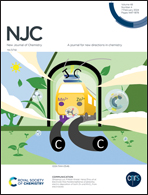A highly efficient MoOx/Fe2O3 photoanode with rich vacancies for photoelectrochemical O2 evolution from water splitting†
Abstract
Photoelectrochemical O2 evolution is the decisive step in photoelectrochemical water splitting. Among many photoanode materials, Fe2O3 has attracted much attention for its ideal band gap and excellent light-absorption ability. However, surface defects and the easy recombination of photogenerated electron and hole pairs result in a low photoelectrochemical O2 evolution activity from water splitting. In this study, the passivation layers of MoOx and oxygen vacancies were introduced on the surface of Fe2O3 by a simple solvothermal treatment method, which could efficiently enhance photoelectrochemical O2 evolution activity from water splitting. The MoOx/Fe2O3-3 sample showed the best photoelectrochemical O2 evolution activity from water splitting. The photocurrent density of MoOx/Fe2O3-3 reached 3.3 mA cm−2 at 1.23 V vs. RHE, which was 5.6 times that of Fe2O3 (0.58 mA cm−2). The passivation layer of MoOx was confirmed by HRTEM and XPS, while the presence of oxygen vacancies was confirmed by EPR and XPS. The passivation layers of MoOx and oxygen vacancies introduced could reduce the number of surface defects, increase the carrier density, enhance the injection efficiency of surface holes into the electrolyte, and promote the separation efficiency of photogenerated charges, leading to an improvement in the efficiency of photoelectrochemical oxygen production from water. This study provides a new idea and method for the development of photoelectrochemical O2 evolution technology.



 Please wait while we load your content...
Please wait while we load your content...